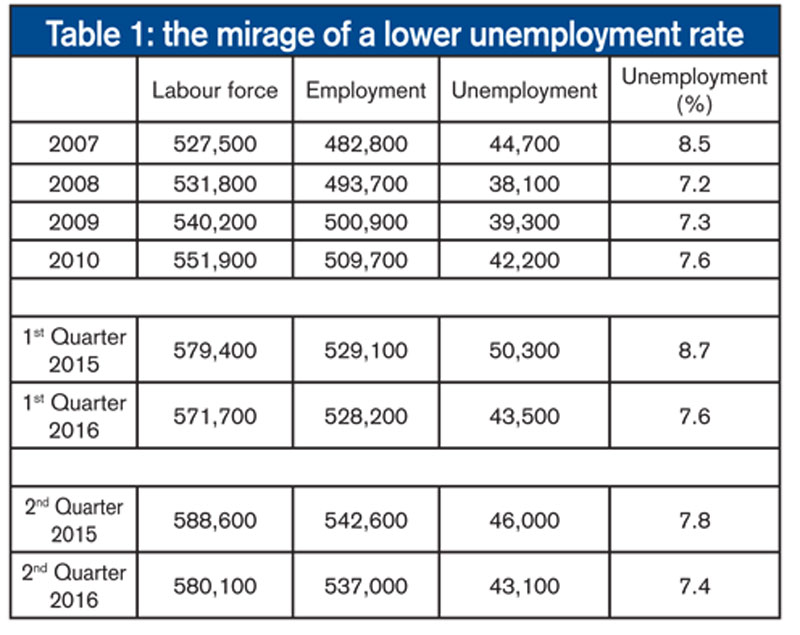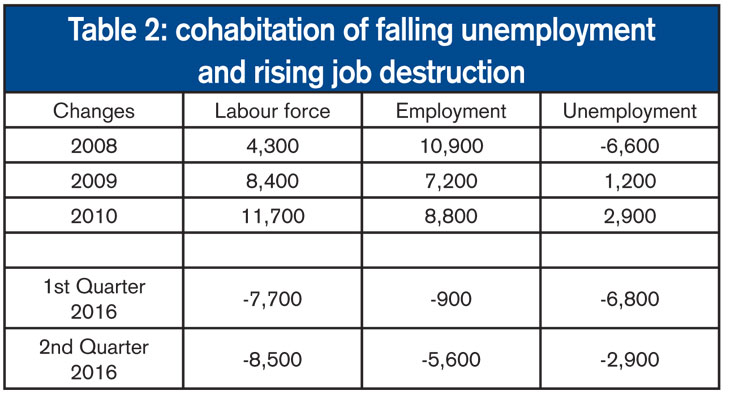Publicité
The enigma of falling unemployment and rising job destruction: beware of irrational exuberance
Par
Partager cet article
The enigma of falling unemployment and rising job destruction: beware of irrational exuberance

The author sheds light upon the recent decline in the unemployment figures, cautioning against too rapid congratulations and the need to get to the depths of the labour market mechanisms.
1.The problem stated
Some are delighted at the slump in the unemployment figures for the second quarter of 2016. Some are even extolling that 7.4 % is the lowest level of joblessness since 2003. The objective of this article is not to take aim at anybody or enter into a sterile debate on the accuracy of this statement but much more to caution against effusive zeal and to throw light on the risks of concentrating only on the mechanical decline in the unemployment statistics without an informed understanding of labour market dynamics. Failure to comprehend such economic nuances may lead to profound disillusionment in the employment strategy, especially the promise of the Economic Agenda to generate 20,000 to 22,000 net jobs per annum, over five years.
When we speak of the unemployment rate declining, we usually think of a situation where an unemployed worker gets a job and moves from unemployment to employment. The ranks of the unemployed would decline, the number of people in employment would rise while the size of the labour force would stay the same. The best outcome from a socio-economic standpoint is for unemployment to decline while employment grows.
But the unemployment rate could decline in another way. An unemployed worker could drop out of the labour force, reducing the size of both the number of officially unemployed workers and the labour force. This seemingly contradictory result produces a lower unemployment rate with job losses.
The lethal blunder is to assume that a fall in the unemployment rate necessarily implies a rise in employment and that net jobs creation is significantly positive. Unfortunately this is not always the case as is borne out by the official figures published by Statistics Mauritius.
Those who study economics know fully well that falling unemployment in itself is no guarantee that enough net jobs are being created to fulfill the legitimate aspirations of those seeking gainful employment. It is possible for the unemployment rate to decline even in a context of no job creation. Worse, the predicament could be aggravated by significant job destruction. It is a fundamental reason why many countries have a greater focus on job creation rather than on the rate of unemployment on a stand-alone basis.
It is important to understand a very simple equation in labour economics.
Labour force = employment + unemployment.
The labour force is made up of those who are in employment and persons who are unemployed. It is a critical nexus. All three can be tweaked, if not doctored, to paint a brighter picture than warranted by ground realities.
The unemployment rate is obtained by dividing the unemployment figure into the labour force. Far from the lower unemployment rate being a cause for a good cheer, it could point to a disturbing new trend in the labour market when all three components witness a downward trajectory.


2.When falling unemployment could mean significant employment creation but also substantial job destruction
Tables 1 and 2 illustrate the two cases of lower unemployment referred to above.
i) A fall in unemployment that leads to rising employment. It is a good outcome.
A decline in joblessness accompanied by significant job destruction. It is a poor result.
ii) It underscores the conundrum in a very simple but compel- ling manner. We compare the labour force-employment-unemployment nexus between 2007 and 2010 and also consider the same relationship between the first and second quarters of 2016 and the same periods in 2015.
The contrast and the policy lessons could not be starker.
i) In 2008, the labour force grew by 4,300 over 2007 while the number of net jobs created was very high at 10,900. As a result, unemployment came down both in absolute term by 6,600 from 44,700 to 38,100 and as a percentage of the labour force to 7.2 % from 8.5 % in 2007. It is clearly one of the best policy outcomes;
ii) In 2009, the labour force in- creased by 8,400 from 531,800 to 540,200 while net employment went up by 7,200. Consequently, unemployment rose slightly by 1,200 in absolute term and to 7.3 % as a share of the labour force. This is still a good outlook with a significant 7,200 net jobs created;
iii) In 2010, there is a hike in the labour force of 11,700 while net employment grew by 8,800 from 500,900 to 509,700. It led to higher unemployment both in absolute terms by 2,900 and in relative terms to 7.6 % of the labour force. However, it is still a honourable achievement with a substantial 8,800 net jobs generated.
Consider what has happened in the first and second quarters of 2016 compared to the same periods in 2015.
iv) For reasons that are not explained in the official documents, the labour force shrank by 7,700 in the first quarter of 2016. However there is also a net loss of 900 jobs from 529,100 to 528,200. As unemployment is the difference between the labour force and employment, it fell by 6,600 thus leading to an unemployment rate of 7.6 % compared to 8.7 % one year earlier;
v) The situation is much worse in the second quarter of 2016. The labour force declined by 8,500 compared to the same period in 2015. However, there is a significant destruction of 5,600 net jobs from 542,600 in 2015 to 537,000 in 2016. Mechanically, the unemployment level dropped to 7.4 % from 7.8 % because of the nexus among labour force, employment and unemployment. However, the fall in unemployment is not attributable to people being shifted from the jobless cohort into the ranks of the employed but to the huge reduction in the labour force. This is what is being celebrated!
3. What is the story behind the story?
Does that riddle explain the chasm between the official unemployment statistics and the observed reality that one of the major concerns of many of our compatriots is an acute lack of jobs to meet their legitimate aspirations?
We need to disentangle this fascinating paradox as it is a real headscratcher. Already, our labour force participation rate is low for an upper middle income country. It is even much lower for females. And to make matters worse, it is now declining. This would be a catastrophe from a policy standpoint as we need a higher activity rate to face some of the daunting challenges of our country, especially that of an ageing population.
Are people being removed arbitrarily from the labour force because of a problem of definition? For instance, any worker without a job who is not counted as officially unemployed is considered not to be in the labour force.
Is there a discouraged-worker phenomenon where employees pull out of the labour force as job prospects peter out? With the resulting effect of an artificial fall in the unemployment rate while jobs are being axed.
Are people being included in the employment statistics to show an improved job predicament? For instance, anybody aged 16 years and above, who has worked for pay for ONLY ONE HOUR during a week is considered as in employment. Equally. An apprentice who is being trained and receives some stipend is treated as employed.
There is also anecdotal evidence that the underemployment rate has increased significantly.
4. Get our priority right
Simply relying on the unemployment rate as an indicator of the health of the job market masks underlying problems. It would be an unmitigated disaster if a lower unemployment rate were contingent on two awful factors. First, a lower activity rate which spells economic calamity in the medium to long term and second a destruction of jobs which frustrate the aspirations and expectations of our compatriots. Job creation is key to reversing this downward spiral. The more so at a time when male youth unemployment has shot up from 15.1 % in 2008 to 21.6 % in 2015 while female youth joblessness has soared from 25.3 % to 32.7 % over the same period. And rising.
It is high time we focus on net job creation and not get distracted by a mechanical fall in the unemployment rate.
Publicité
Publicité
Les plus récents






